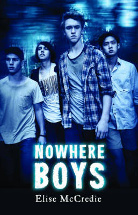Nowhere boys by Elise McCredie

Hardie Grant Egmont, 2014. ISBN 9781760120160.
Recommended for middle years readers. Nowhere boys, which has been
serialised for television, tells the story of four very different
boys in Year 10 who become friends in difficult circumstances. Felix
is a punk songwriter, Andy an Asian science nerd, Jake a bully with
a disadvantaged background and Sam the all-round popular sports
hero. When the four are thrust together on a school excursion it
seems unlikely that there will be a productive outcome. However,
Felix, who feels responsible for his brother's paralysis and hopes
to invoke the help of supernatural powers to reverse the past,
manipulates the situation so that he can make contact with forces in
the forest. The boys become lost and do attract the attention of
otherworldly powers. When they make their way home they find that
they are 'nowhere'. They either do not exist or have been replaced.
Their parents do not recognise them, their homes have changed, even
their girlfriends have moved on. Tired, hungry and unhappy they are
forced to look after themselves, while trying to find out exactly
what has happened. When Felix borrows a spell from Phoebe, the owner
of the local magic shop, their troubles worsen when the supernatural
powers are antagonised even more. The boys are attacked by swarms of
bees, then crows and finally dogs. Specific humans seem to respond
to them manically, and it becomes clear that a demon has become
disturbed and is attempting to destroy them. Felix realizes that a
talisman borrowed from Phoebe can protect them if all four are
present. Each of the four represents either earth, fire, water or
air, and all four elements are needed. The boys realise that,
despite their differences, they do need each other, and they develop
a grudging respect for all their different talents. They are
restored to their former lives with the help of the talisman, but
there are clearly more adventures to follow as the temporarily
defeated demon reappears in a new form on the last page. The story
is quite simply written though the plot has a number of
complexities. The characters are believable, even though each of the
boys represents a 'type' and the minor characters are also
stereotypes. It is recommended for middle years readers.
Jenny Hamilton